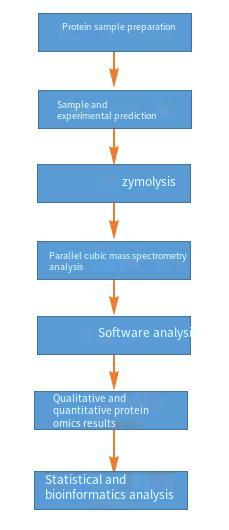飞凡检测致力于打造国内专业的第三方检测服务公司,不断优化整合市场检测资源,飞凡检测与多家科研院所,如上海同济大学,苏州大学,以及国内众多知名的检测公司进行深度合作,共同为国内制造业服务,为中国的制造业开拓海外市场保驾护航,为我们日常生活的健康安全树立标杆;公司目前工程师百余人,95%以上是本科以上学历;我们合作的实验室通过CNAS,CMA(EZ),所出具的任何一张报告都有CNAS,CMA资质,确保出具的每份报告都具有权威的法律效力。
Label-free: Label-free quantitative proteomics studies use liquid-liquid mass spectrometry to analyze enzymatically digested peptides of proteins without the need for expensive stable isotope labels as an internal standard, and only need to analyze the mass spectrometry data generated from large-scale identification of proteins and compare the signal intensities of the corresponding peptides in different samples, so as to perform relative quantification of the proteins corresponding to the peptides.
There are two main types of quantification processes that rely on the analysis of complex information to complete the quantification process:signal intensity and spectral counting methods. The former is based on primary mass spectrometry-related peptide peak intensity (Mass spectral peakintensity), peak area (Peak area), liquid chromatography retention time (lCretention time) and other information for quantitative analysis; the latter is based on secondary mass spectrometry-related peptide number of times each protein is identified to the total number of peptides (Peptide hide or The latter was quantitatively analyzed based on the total number of peptides identified per protein by secondary mass spectrometry (Peptide hide or Spectral counts), the ionic valence of identified peptides (lon counts ofidentified peptides) and other information.
1、Data output statistics
2、Protein identification results
3、Protein quantification results
4、Protein GO analysis
5、Protein COG analysis
6、Protein Pathway metabolic pathway analysis
7、Differential protein GO enrichment analysis
8、Pathway enrichment analysis of differential proteins

1, to be detected protein requirements: intact and no obvious degradation of the total protein, protein amount of a minimum of 300ug, the concentration of a minimum of 5ug/ul; protein extraction reagents require the use of ordinary tissues, cell lysate can be, do not use two-dimensional electrophoresis reagent extraction;
2.Provide tissues or cells directly, for cell samples, cell volume >107; for tissue samples, wet weight of animal and microbial tissues >10mg; for plant fresh tissues >100mg; for body fluid samples, volume of blood >500μl, all the follow-up operations will be done by Tinker Biologicals, and you only need to provide the samples, and no other reagents are required.
3、Protein transportation: can be transported at 4 degrees within 24 hours;
4、Protein long-term storage: -20 ℃
Feifan test quality inspection report process:

1、 Provide product information
2, engineers according to your product information products recommend the appropriate testing program, and give a quotation
3、 Confirm that there is no problem with the offer, and then send the sample to our laboratory
4、 Pay for the testing costs, arrange for testing
5、The test is completed, the test report is issued and mailed to the customer.

飞凡检测致力于打造国内专业的第三方检测服务公司,不断优化整合市场检测资源,飞凡检测与多家科研院所,如上海同济大学,苏州大学,以及国内众多知名的检测公司进行深度合作,共同为国内制造业服务,为中国的制造业开拓海外市场保驾护航,为我们日常生活的健康安全树立标杆;公司目前工程师百余人,95%以上是本科以上学历;我们合作的实验室通过CNAS,CMA(EZ),所出具的任何一张报告都有CNAS,CMA资质,确保出具的每份报告都具有权威的法律效力。